It’s no secret that Kelsey and I enjoy great wine and food, so Mendoza, Argentina was a logical step on our honeymoon. The epicenter of one of the main wine producing regions in Argentina, Mendoza is a small city at the edge of the Andes in what apart from the irrigated vineyards is a dusty, dry region. We were looking forward to visiting some vineyards but mostly to going to the Termas de Cacheuta spa up in the mountains outside the city.
Our first few hours in Mendoza did not go super well. The flight from Santiago, which I had been looking forward to in order to see some amazing mountain vistas from above, was cloudy for all but 30 seconds. Kelsey and I couldn’t sit together because LATAM kept changing the plane type (or something), and about halfway through, there was a terrifying drop as we went through some turbulence over the mountain range. I think Kelsey thought that was the end for us, so she would have liked to be sitting next to me in that moment. I think she probably would have broken my hand squeezing it if that had been the case. Once on the ground, we had some trouble getting checked into our Airbnb as the host’s delegate was uncommunicative while I still had internet, then late while we were waiting for him in the dark, then entirely useless as when we got into the apartment and he didn’t even know where the bathroom was, much less how to use the stove. To make matters worse, we had bought a local SIM card and couldn’t get it set up, so we went to bed feeling a bit frustrated.
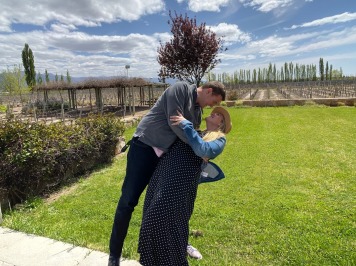
Things were much better then next day! We had booked a wine tour with Bus Vitivinicola, which is a hop-on/hop-off service that loops around several wineries in different areas of Mendoza, depending on the day. On our day, we toured around Lujan de Cuyo, which is regarded as the second-best wine region in Mendoza, behind the far-off Valle de Uco. I would have preferred to rent a car and do the tour ourselves, but Argentina (and Chile and Uruguay) has a zero-tolerance drunk driving policy, so tours are pretty much the only way to go. Typical wine tours cost around $175-200 per person, but our trusty wine bus ended up costing easily less that half of that, including all the wine tastings and a fancy lunch. I also liked how with our bus tour, while we could only choose from six wineries on the circuit, which four we visited and the order we visited was mostly up to us. And since we were more interested in smaller wineries than the rest of our bus group (a grand total of 10 people), often we were some of the only people there and got a very personalized experience. My lack of Spanish ability also helped—in one case, we got a private tour in English while the rest of the bus got grouped in to a bigger tour.
Okay, so on to the wineries. Our first stop was Ruca Malen. We were very impressed with them, particularly their pinot noir, which apparently they only started selling that same day. It was also interesting because pinot noir was treated as a specialty variety of grape (nobody on our tour had ever had it). This is because Argentina simply does not import foreign wines, so good cool-climate wines are tough to find. We picked up a bottle of the pinot noir (for like $8 I might add) and hopped back on the bus to go to Cruzat, a sparkling wine producer nearby. This was probably my favorite stop for two reasons. First, this was our English-only private tour. As much fun as it was for me to try and understand a 30-minute-long tour conducted in Spanish, it was refreshing to actually understand what was happening! The other reason was that it was really cool to learn about what the methode champagnoise process of making high-end sparkling wines actually entails. It was much more involved than I thought. They were also in the process of bottling their wines, so watching their assembly-line process for removing sediment, topping off the bottle, corking, and labeling was very interesting and a pretty unique experience. We weren’t particularly wowed at the tasting, though we did learn a unique method for sampling sweeter wines, which led to many giggles.
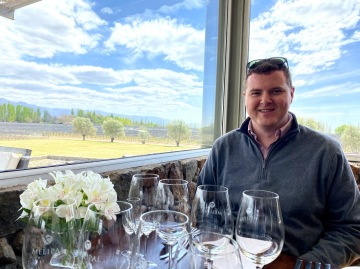
Next we headed to Melipal for lunch. Lunch at Argentine wineries is very different from wineries in the US as it is not yet a standard practice in the US for every winery to have a high-end restaurant on site. However, in Argentina, that’s just to be expected—pretty much every winery has a restaurant that serves a multi-course lunch to pair with different wines. Melipal was a beautiful spot to have lunch but I found the lunch to be just okay. Also, they had a Malbec-heavy lineup of wines to taste, and I find that I just don’t like Malbec a terrible lot. After lunch, we were ready to go home, but there was still one more winery to visit—Renacer. Here we had another tour and had some more wine (imagine that!), none of which was awesome enough to commit to carrying around for 10 more days but all of it was good. After this, we finally headed home, bellies a bit too full of wine.
Wine tasting in Argentina was very different than what we’re used to in the US, and I’m not sure I mean that in a good way. Most often, Kelsey and I taste at Thomas Fogarty where we are members and get free tastings, so the staff behind the counter basically creates a flight of 5-8 wines depending on what they have open at that moment. However, on our wine tour, we never tasted more than 3 wines at one place. Yet, each winery had a whole catalog of different wines for sale. It seemed weird to me to taste so few wines and then buy bottles of different vintages and varieties sight-unseen. The other major difference is that in Argentina, wine tasting (in my experience) always includes a tour of the vineyards, production facilities, barrel rooms, etc. And while this is interesting once or maybe twice if things are really different, by the end of a long tour of multiple wineries, you kind of get the point. But all in all, we were glad to have done the tour, and especially glad to have done it in a cost effective way that got us a taste of what wine culture is like in Argentina.
That night, we dined at Azafran, a fine-dining restaurant in downtown Mendoza whose claim to fame is having a wine cellar where you walk up and pick out a bottle yourself, rather than reading off a wine list. However, we were very full of wine and couldn’t stomach a bottle, so we didn’t take advantage of this. The meal was very good, however, and we decided to come back later on in our trip when we weren’t so freaking full.
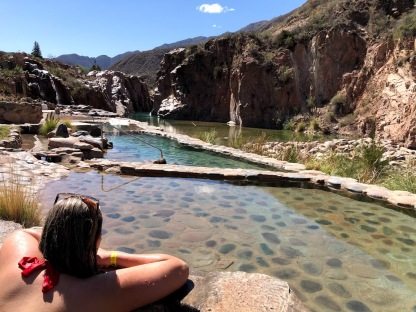
The next day, we had our spa day. The honeymoon had been hectic so far and we were looking forward to a much-needed day of relaxation. We headed to the meeting point for the bus there and waited…and waited…and waited…about an hour in total. Kelsey does not do well waiting for things, so this was a less-than-ideal start to the day. But finally, it came, and we squeezed in the back of the bus and headed into the Andes. When we got there, the scenery did not disappoint. The spa itself is a series of thermal pools build into the side of the river canyon. The pools range in temperature from probably about 70 to 100 degrees. As we were visiting on a weekday in the very beginning of spring, we only had to share the resort with maybe 30 other people. But, since it was the beginning of spring, it was quite cold in the morning and the resort’s recommendation of starting in the cool pools and working our way to the warm pools was just not going to happen, so we hopped in halfway through the course and enjoyed the warmth. There was also a private cave with a powerful water hose and massage table, and since no one else seemed to know about it, we hung out in there, taking turns blasting the other with the hose. We relaxed and enjoyed the views for the rest of the morning before heading up to lunch—our first asado experience.
The asado was a huge spread of grilled meats, salads, sides, vegetables, and desserts. Some of it was great—it’s easy to please with a steak buffet—while some of it, like the grilled pig intestines I hesitantly tried, were not. We took full advantage of one of my favorite features in Argentina, retail-priced wine in restaurants, and had a bottle of red wine from the Uco Valley region of Mendoza, often considered the region’s best (for $10!). After a few scoops of DDL for dessert, we headed back down and enjoyed more spa time in the pools, mud bath, saunas, and steam room.
I was almost persuaded not to go to the spa by reviews from the internet saying it was dirty and rundown. But I think Termas Cachueta is a perfect example of why you should never listen to whiny Americans on TripAdvisor. Was it the Four Seasons? No. But was it gross in any way? Absolutely not. This is a locally owned and operated resort with beautiful facilities and amenities. And for the price—a full day pass plus transportation and a steak lunch was $50 per person—it is a fantastic value. In short, people on the internet are annoying so don’t listen to them unless there’s a lot of bad reviews in the local language.
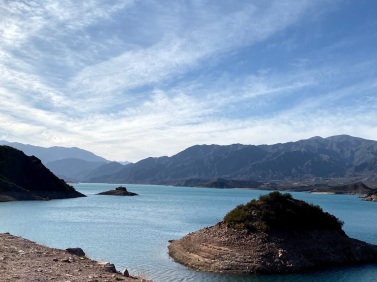
On the way back from the spa, Kelsey and I were both tired, wet, and ready to go home. But instead our bus took a detour to go to a scenic overlook. I was moaning and groaning about the extra travel time until the bus emerged from the tunnel and we were overlooking a beautiful mountain reservoir with deep blue water ringed by the Andes. It was absolutely gorgeous, so we jumped off the bus and took pictures for a few minutes.
When we got back on, I reached in to the backpack for some alfajores that Kelsey had bought ealier, only to find out they had been pulverized to dust and DDL goop. I gasped and said, “My heart!” in a funny voice while Kelsey was chugging water, and apparently she thought that was so funny that she laughed, choked on the water, and sprayed the two rows of people in front of us with the water that had been in her mouth. I have never seen anyone turn as red as Kelsey did.
That night something possessed us to go out for sushi. I think we were in the mood for something light and open fairly early, but I’m still not sure. We found ourselves at a very trendy looking place and ordered a platter. Here’s a lesson on South American sushi. Nigiri does not exist, the only fish used is salmon, rolls may have the same name as they do in America but that does not mean the contents are remotely the same, and everything, without exception, comes with cream cheese. We had ordered a combination platter without paying much attention to what was on it, and we ended up with four of the strangest rolls I have ever consumed. One of them was stuffed with palm hearts, which I did not enjoy, a few had very sweet fruit-based sauces, and all of them, and I cannot stress this enough, were stuffed with cream cheese. While I can’t recommend eating sushi in Argentina unless you know it’s a traditional place (and I’m sure there are legit places in Buenos Aires), it was a fun experience and something that we’ll remember for a while. We finished off the night with some ice cream (DDL-flavored, of course) and turned in for the night.
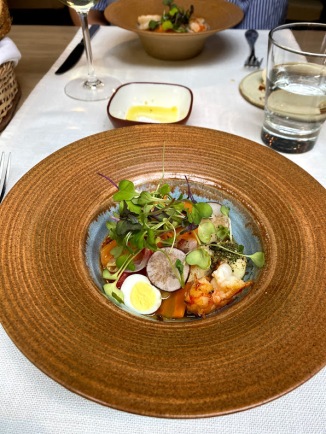
Our last full day in Mendoza was a relaxing one. We had to do laundry and Kelsey really needed someone to fix her nails, which were still sporting the gel French tips from before the wedding. So, we stayed around town and explored the city of Mendoza, which has a reputation among travelers as being a bit boring. We found it to be a very cute city with numerous distinctive plazas, a bustling central market, and pretty tree-lined streets. We returned to Azafran for lunch and had some amazing salmon—much better than the sushi salmon the night prior. Another highlight of the day was seeing the Mendoza branch of the Madres de la Plaza de Mayo marching in one of the plazas. The Madres are the mothers of those disappeared during the military dictatorship, and grandmothers of children who were abducted from their parents (who were killed for being political dissidents) and adopted by military families. They protest in the Plaza de Mayo in Buenos Aires every Thursday, regarding various human rights violations and some still demanding the return of their (now grown) grandchildren. Kelsey was bummed that we would not be able to see them in Buenos Aires, so it was a pleasant surprise to experience it in Mendoza. Otherwise, we spent the day peoplewatching, walking around, and finishing up chores.
On our last night in town, we headed down to the popular nightlife area for an evening snack. We ended up in a traditional tavern-like place that had hearty Argentine favorites. We filled up on beef empanadas and provoleta (grilled cheese, but not like a sandwich, rather a slice of cheese cooked on the grill). It seemed like a fun area to dance the night away, but our sleep schedules just are not compatible with South American nightclub schedules, so we left and had another asado dinner instead. This plate came with all sorts of goodies, which regrettably included morcilla, or blood sausage. I took a bite, Kelsey did not, and I decided that this would just never be something I liked, mostly due to the texture but a lot due to the taste. But the Argentines sure ate it up whenever I saw it being served. Early the next day, we took a cab to the airport and hopped on a flight (on Norwegian of all airlines) to Buenos Aires for 5 days in the capital city.
Mendoza, to me, was one of the highlights of our trip, mainly due to our time at the spa. But it was also just a nice, clean, manageable city with no shortage of activities for a trip of our length. There is excellent food, even better wine, and it’s an interesting experience to be in a place that’s a major tourist destination, just not for Americans and Europeans.
